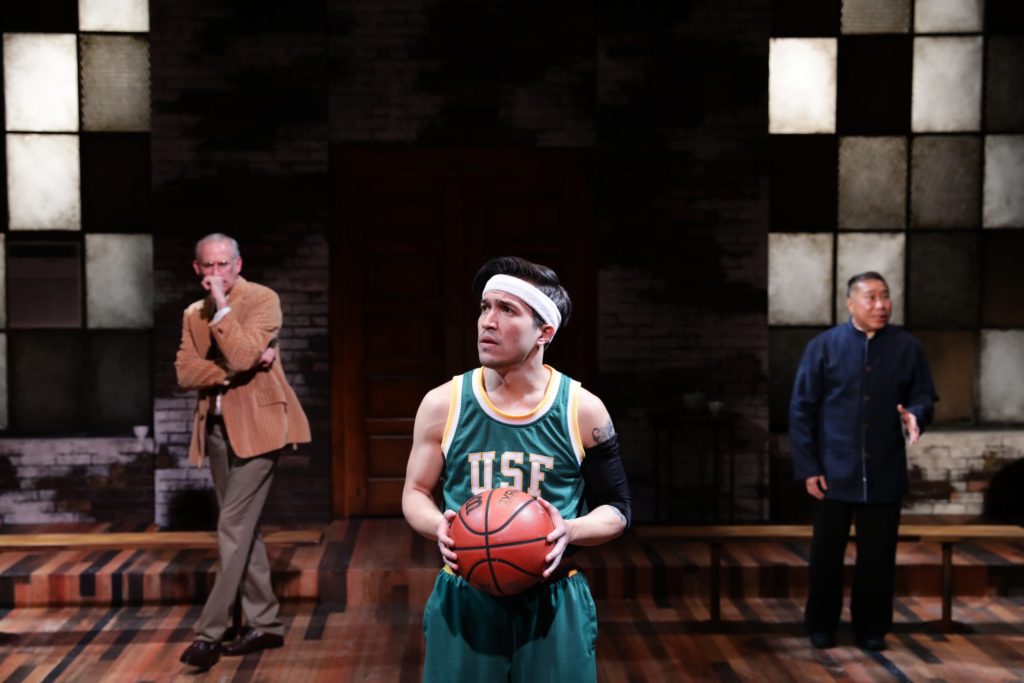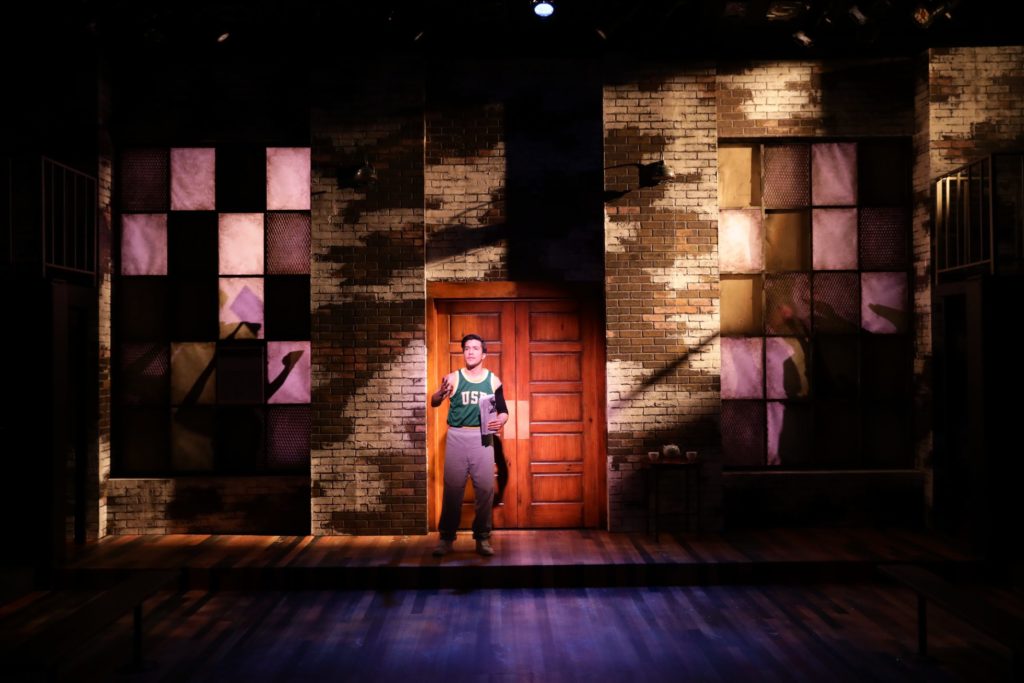
Photo by Mark S Howard.
Presented by Lyric Stage Company of Boston
By Lauren Yee
Directed by Michael Hisamoto
Featuring Barlow Adamson, Jihan Haddad, Gary Thomas Ng, Tyler Simahk
Scenic Design: Baron E. Pugh
Costume Design: Seth Bodie
Lighting Designer: Michael Clark Wonson
Sound Design: Elizabeth Cahill
February 24 – March 19
140 Clarendon St
Boston MA 02116
Critique by Maegan Bergeron-Clearwood
BOSTON, MA — Sports are theatre: bodies are in motion, in the here-and-now of time and space, performing feats of incredible physical achievement, telling riveting stories about power and pathos. Staging sports-themed plays, therefore, offers inherent performative, spectacle-driven potential.
Unfortunately, the Lyric Stage’s production of Lauren Yee’s The Great Leap doesn’t quite tap into. For only having four characters, The Great Leap is a surprisingly busy play, which makes the flatness of the production particularly noticeable: the script is full of entangled plot lines and intersecting themes, often to its detriment.
Lauren Yee, one of the country’s most-produced playwrights, is known for snappy, fast-paced stories that deftly weave together personal and political themes, often inspired by her own family history. The Great Leap is characteristically both intimate and sweeping in scope, but the result feels mostly messy.
Beginning in 1989 San Francisco, the play is about teenager and aspiring basketball pro Manford Lum (played enthusiastically by Tyler Simahk), who elbows his way onto a college team for a friendship game with Beijing. But, The Great Leap is actually about the coaches, the men who don’t play, but “stand still:” has-been, humorous, and casually racist Saul (Barlow Adamson) and quiet, careful Wen Chang (Gary Thomas Ng). The ensemble is rounded out by Manford’s cousin/parent-figure, Connie (Jihan Haddad).
The script has various issues, from unclear emotional arcs and motivations to glaring plot holes to the underdeveloped women characters (Connie, but also Manford’s deceased mother). Most frustrating is its handling of political themes. Yee sets the play against the backdrop of the Tiananmen Square protests, but she doesn’t flesh out this broader political conflict; as a result, the protests feel like a gimmicky prop, rather than a catalyst for exploring culture and identity. All four actors in the Lyric production are clearly doing their darndest with the dialogue they were given, but, because some of the arcs and relationships feel unfinished, there’s only so much the cast can do to make the scenes come alive.
Still, the play has exciting staging opportunities – there is a literal basketball game in the second act – but these are largely missed by director Michael Hisamoto, and the design team. This is most obvious with the unimaginative use of space.
The set (designed by Baron E. Pugh) is a gesture toward a basketball court, but the symmetry and flatness do little in the way of storytelling; there is some interesting use of shadow work to depict moments from Wen Chang’s memory, but these moments are few.

Photo by Mark S Howard.
The staging is also fairly static: despite the metaphorical, dynamic potential of the play’s theme, there is little physical exploration of character or power dynamics – all which exacerbated by an inconsistent use of lighting and sound elements. The most vibrant design elements come from costume designer Seth Bodie, who clearly had lots of fun playing with ‘70s and ‘80s aesthetics.
The challenge of putting sports onstage boils down to expectations: games are theatrical, but they are also linear and contained, such that they are often best suited for the world of realism (there’s a reason you can name more sports films than plays). Because theatre cannot offer much in the way of gritty hyper-realism, successfully staging a sports play necessitates leaning into theatre’s secret weapon: suspension of disbelief.
Instead of attempting to stage a straightforward act two basketball game, why not experiment with something stylized, metaphorical, or even strange? This production falls awkwardly in the middle: not able to deliver a realistic depiction of the play’s themes, but not daring enough to fully theatricalize them, The Great Leap at the Lyric doesn’t quite make its shot.
